The M1A1 Thompson is heavy, loud and as effective downrange as a bulldozer, just like the Americans who carried it. Though technically obsolete at the beginning of World War II, the Thompson saw active service until the Vietnam war.
By Will Dabbs, MD
The Four Preeminent World War II Submachine Guns Shoot It Out for Supremacy
What happens when you get a group of friends together to do some recreational blasting and suddenly realize that you have representative samples of each of the submachine guns used by the major powers who fought the war in Europe in WWII? You burn through a lot of ammunition and spark some spirited technical discourse.
Pistol-caliber submachine guns have lost their allure these days in favor of compact, rifle-caliber platforms that provide better penetration and greater range. However, there was a time when the submachine gun was the ultimate cool-guy iron. Troops of all flavors in World War II bartered for them and even used captured examples of foreign guns when ammunition was available. What is fascinating, however, is to appreciate the disparate mindsets that drove each of the main powers in the European Theater in World War II to design the weapons that they produced and employ them so differently.
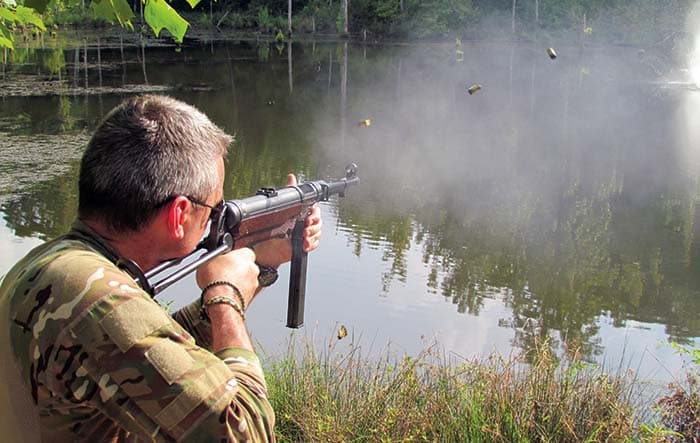
USA
American submachine guns in World War II were much like the Americans who carried them—loud, heavy, and undeniably effective. Firing the enormous .45 ACP cartridge, the early 1928 Thompson weighed nearly eleven pounds when equipped with a fully-loaded magazine. The Thompson was technically obsolete at the outset of the Second World War, yet it soldiered on for lack of an appropriate replacement all the way to war’s end. The heavy forged receiver and fire control group were expensive and difficult to manufacture, but legendarily robust as a result. The simplified M1 and M1A1 Thompsons dispensed with the finned barrel and Cutts compensator as well as simplified the bolt assembly, but they were still difficult to manufacture. A M1 Thompson cost the U.S. government about $45 to produce back during the war.
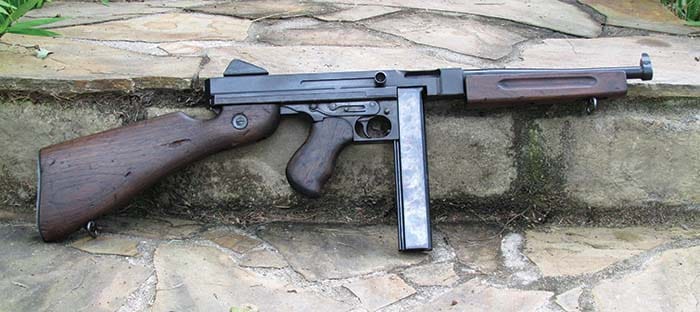
The erstwhile replacement for the Thompson was the M3 Grease Gun. By contrast, the Grease Gun was built entirely of steel and was designed for ease of manufacture. The M3 set the government back about $18 per copy. The Grease Gun exhibited a remarkably slow rate of fire of around 450 rounds per minute and was either loved or hated by its users. The utilitarian appearance of the weapon was objectionable to many troops raised on forged steel and oiled walnut.
In American usage, submachine guns were specialist weapons used primarily by tankers, MPs and paratroopers. I have a friend who fought in the Infantry, all the way from North Africa through Sicily and up through Italy and Monte Cassino, who told me he never saw an American submachine gun in combat. Greatly coveted by front-line soldiers, submachine guns were cherished treasures when they could be obtained.
UK
More than the other three countries profiled herein, Great Britain was in a fight for its life early in World War II. Finding itself bereft of weapons after the miraculous evacuation at Dunkirk, the British were desperate for small arms. They purchased thousands of Thompsons in exchange for gold early in the war, as there simply was no other option available in quantity. With their backs literally at the ocean, the British Army needed a submachine gun that could be produced cheaply and rapidly. Tactical functionality had to take a back seat to these considerations, but the resulting weapon was still surprisingly effective.
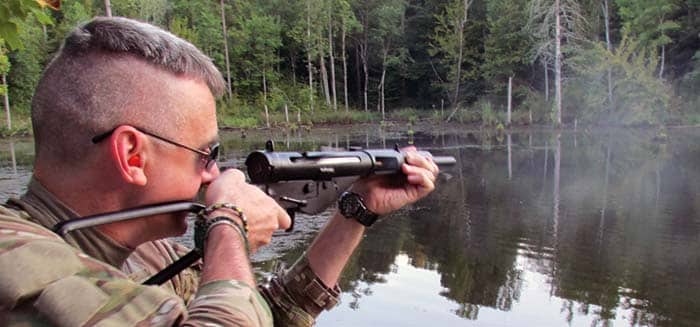
Designed by R.V. Shepherd and H.J. Turpin at the Enfield manufacturing plant, the Sten took its name from these three sources. Alternately referred to as the “Woolworth Gun,” “The Plumber’s Delight,” and “The Stench Gun,” the Sten was (and is) undeniably bug ugly. The Sten evolved through several marks and the final Mk V sported nice wooden furniture, high quality sights, and a bayonet lug. The Mk IIS and Mk VI variants were the world’s first sound-suppressed submachine guns in common use.
Thousands of Stens were airdropped into occupied Europe for use by the Resistance against the Germans and the sound-suppressed version was state-of-the-art spy gear for its day. The story goes that a partisan attempted to execute deposed Italian dictator Benito Mussolini with a Sten gun only to have it misfire. A comrade subsequently did the deed with a Thompson.
The British issued Stens to Airborne troops, as well as officers and NCOs of other branches whose duties were better suited to a small, portable automatic firearm. While Stens were produced by the million in a variety of Marks, they typically cost about $9 to build. One of the brilliant aspects of the Sten’s design was that its component parts could be manufactured in small shops that were readily dispersed and concealed. The tolerances on the Sten are such that it was fairly forgiving regarding quality control.
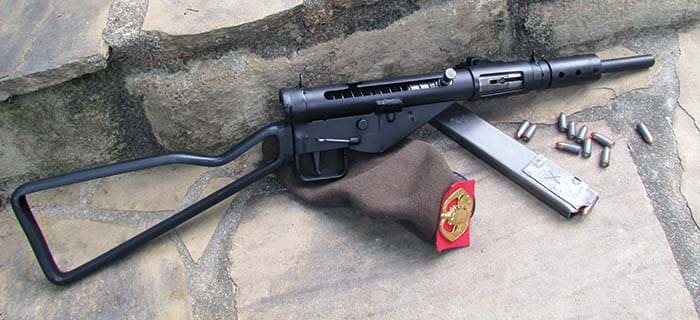
USSR
The Soviet Union in World War II was essentially a peasant nation in possession of tremendous natural resources. Adolph Hitler, hungry for Russian raw materials and with a legendary disdain for anyone lacking blonde hair and blue eyes (Hitler’s own hair was brown, by the way), launched Operation Barbarossa in June of 1941 with the intent of securing the USSR’s vast resources for himself. Soviet defenders were initially violently thrown back until the heartless Russian winter ground the German offensive to a halt. In times of dire national crisis the Soviet submachine guns reflected the Russian character—robust, simple and plentiful.
While the stories of the PPS-43 being delivered directly from the manufacturing plants to the front lines a few blocks away are commonly known, the marginally more refined PPSh has more sex appeal. Designed by Georgi Shpagin and known to the Russians by his surname eponym, the PPSh fired a bottlenecked high-velocity 7.62x25mm cartridge at a prodigious rate of fire. The weapons were constructed predominantly of sheet steel stampings and fed from either a 35-round box magazine or a 71-round drum. The PPSh, equipped with its characteristic drum magazine, became a visual icon that personified Russian nationalism in their fight to the death with Nazi Germany.
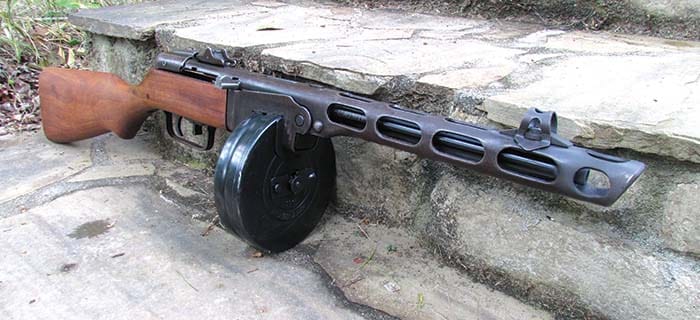
In contrast to other combatant nations in WWII, the Soviets fully embraced the concept of the submachine gun as an Infantry combat arm. They at times equipped entire battalions solely with submachine guns and used them to tremendous effect in the brutal street fighting that characterized their push back across their homeland and into Germany. The overwhelming firepower afforded by massed formations firing submachine guns most have been utterly overwhelming at close ranges.
Germany
The Germans have a well-deserved reputation for superlative engineering. Many of the well-known German manufacturing firms today had their genesis in military production generations ago. For example, BMW produced aircraft engines, Porsche built tank turrets, and Mercedes turned out military trucks. As has been the case for our other three examples, German small arms reflect their national identity.
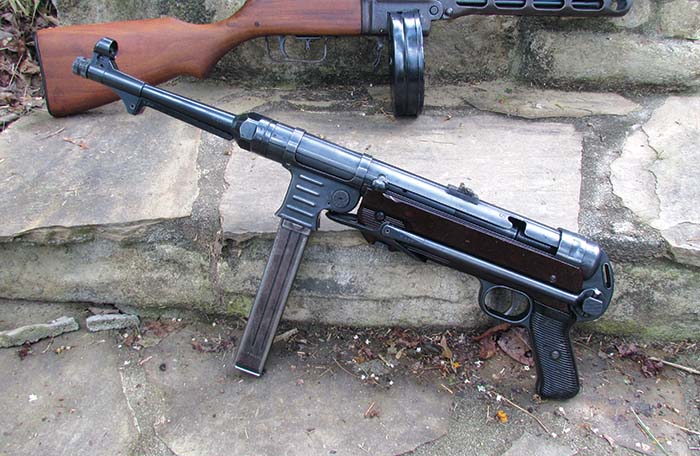
Until the necessities of war drove them to cut corners, German military small arms were works of art. Handling Luger P08 pistols or MG34 machine guns manufactured in the late 1930s is a breathtaking exercise for the engineering-savvy firearms enthusiast. In the case of submachine guns, the Germans struggled to standardize. Roughly half a dozen disparate submachine gun designs found their way into the ranks of the Wermacht and Waffen-SS in the early days of the war until martial necessity drove the Waffenamt to settle on a single design.
The MP38 was a revolutionary weapon. For starters, it was all steel and synthetic materials, with no wood of any sort. While the MP38 incorporated a machined receiver that was fairly difficult to produce, the more common MP40 that replaced it was an exercise in sheet steel art.
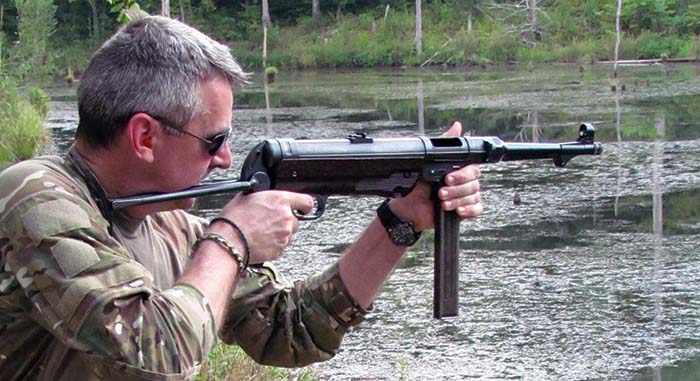
More than a million MP40 submachine guns rolled off the lines in WWII and they equipped every branch of the German military. The Germans used MP40s heavily among paratroopers and tank crews and also issued them to officers and NCOs who needed a small, portable weapon to facilitate leadership duties. Anecdotal evidence supports the issue of MP40s to troops in combat, particularly on the Eastern Front, as a reward for valor and exceptional combat effectiveness.
Magazines
Thompson magazines were of a double stack design and subsequently easily loaded with nothing more specialized than a standard set of human fingers. The magazines for the M3 Grease Gun, the Sten and the MP40 were double stack designs that tapered to a single column for presentation of rounds into the breach. As a result, they required a dedicated magazine loader and were incrementally less reliable in action as a result. All three can be loaded using a small dowel or piece of wood in a pinch, but it gets tedious quickly, particularly when those last few rounds are topped off.
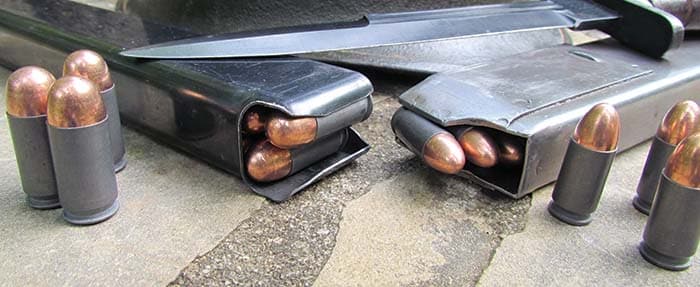
The drum magazine for the PPSh is a fairly complex piece of kit that was nonetheless reliable and effective in combat, due in large part to the fact that the mechanism was well sealed against the elements. These drums, like all drum magazines, are tedious to load and noisy in operation because of the rounds clattering around inside during movement. In addition, when fully loaded they are fairly heavy and ungainly as a result.
Trigger Time
To call a Thompson a boat anchor does disservice to boat anchors. The Thompson is ridiculously heavy when fully loaded. Also, no disrespect to the near-religious acolytes of the Thompson gun, the general design is pretty wretched. The weight is in the rear of the weapon and the axis of recoil is significantly above the buttstock. These two factors are a perfect recipe for muzzle climb. The Thompson can be controlled and kept on target, even on long bursts, but it requires experience, attention and careful application of body weight. Lean into the gun and let the recoil press against gravity for best results. Additionally, the M1A1 Thompson cycles at a spunky 700 rpm and trigger control is important as a result to manage ammunition expenditure.
On the plus side, a cloud of .45 ACP rounds will stop anything that breathes. The controls are fairly well laid out for right-handed operators and the bolt locks open on the last round fired. As a result, the operator need only swap magazines and squeeze the trigger to keep the gun in action. This exercise is easier and faster than on most any other military small arm of any generation.
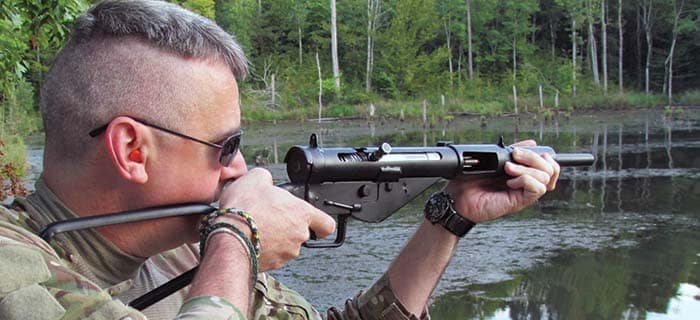
The Sten gun just sticks out all over the place and can seem ungainly as a result. The side-mounted magazine facilitates shooting from the prone position, no small attribute considering this is where most tactical firing is undertaken. The other three competitors must be turned sideways or fired blindly to accomplish the same end, but this feed geometry makes the gun difficult to carry comfortably while slung. All but the Mk III have a swiveling magazine well that may be rotated closed when the gun is stored or exposed to mud and fouling.
The sedate rate of fire of the Sten makes it imminently controllable with trivial training, but the ergonomics are fairly poor. There is no safety per se, though the fire selector is a convenient push-through button accessible with the trigger finger. The T-stock is positively horrid and the loop stock only marginally better. The sights are fixed and welded in place so the zero of the gun is driven by the whim of the welder in question. The magazine release is thick, heavy and difficult to manipulate in a rush.
Firing the PPSh is an altogether unique experience. The gun cycles very quickly, akin to a MAC-10, and ejects the empties straight up into the air. In short order the operator resigns himself to firing a burst, letting the empties rain down on his head, and firing another burst. The effect when three hundred Russian soldiers were firing shoulder-to-shoulder en masse must have been remarkable.
Even with a heavy drum magazine in place, the PPSh requires attention to keep bursts on target given its high rate of fire and were it not for the 71-round capacity of the drum, the gun would run dry with alarming rapidity in action. The fire selector is a pivoting lever within the trigger guard and is easy enough to manipulate. The magazine release is a pivoting lever behind the magazine itself and is fairly easy to use in action.
The MP40 is smooth, accurate, and controllable. The rate of fire is around 500 rpm and its slow cadence makes burst control a joy. The long telescoping recoil system makes the MP40 hands down the most pleasant of the four guns to shoot. However, the design is quite front heavy and difficult to keep in a ready position for extended periods as a result. Additionally, the folding stock is not particularly comfortable and tends to wobble badly over time. In their defense, the German engineers who designed it likely never imagined having a geek like me pick apart their design seventy years after they produced the guns en masse trying desperately to win a global war.
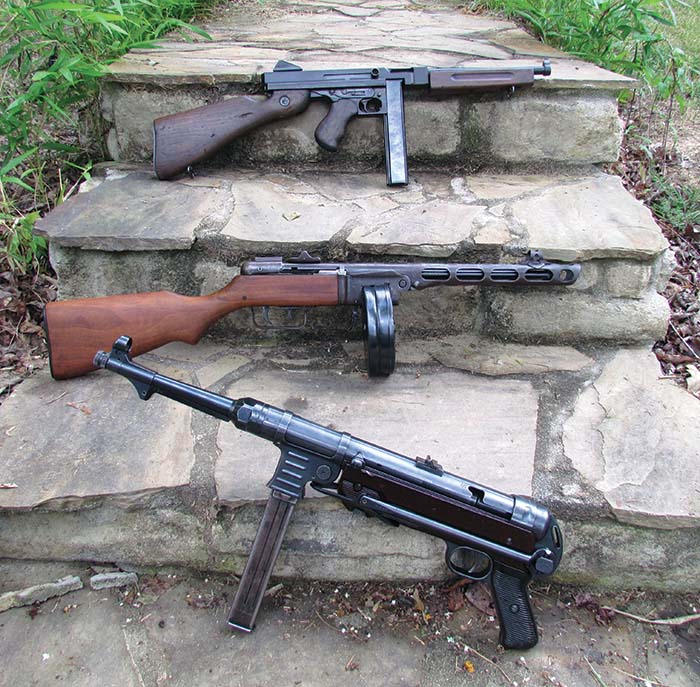
Final Thoughts
The Thompson brings the most firepower to the table, but the prospect of having to hump the thing on a twelve mile forced march is the stuff of nightmares. The Sten does a magnificent job given the desperate circumstances surrounding its production, but being issued such a crude weapon on which to trust your life must have been demoralizing. The PPSh was a devastating CQB tool at close quarters but large formations of soldiers would have consumed vast quantities of ammunition and it would be easy to burn through your basic load quickly in action. The MP40 is a magnificent piece of engineering but at nine pounds and with so much of that weight so far forward, following the thing around corners and through room clearing drills can become agonizing.
So, the bottom line, all four guns are sitting on a table and you have to pick one to use for real. Which one would it be? For me, much to my surprise, I think it would be the Sten. The light weight and slow rate of fire seem to make it the most efficient and practical tactical tool. It certainly has its shortcomings and the decision is not without reservations, but if an MP44 is not a handy alternative the Sten wins in my book, though by a narrow margin over the MP40.
Your mileage may vary, and opinions are like certain unmentionable excretory anatomical structures, everybody has one. However, in the final analysis the Sten puts its rounds most readily on target, best lends itself to being carried around tactically for long periods, and allows relatively accurate fire from the most common firing positions legitimately used in combat. Whoever would have thought?
| This article first appeared in Small Arms Review V19N10 (December 2015) |











